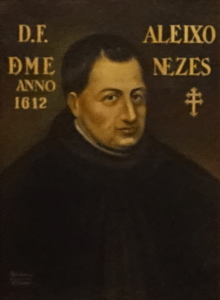Aleixo de Menezes
Archbishop Aleixo de Menezes or Alexeu de Jesu de Meneses (25 January 1559 – 3 May 1617) was Catholic Archbishop of Goa, Archbishop of Braga, Portugal, and Viceroy of Portugal during the Philippine Dynasty.

Biographical sketch
Aleixo was born in 1559. It is known that he joined the Augustinians. He was consecrated Archbishop of Goa in 1595, when he was only 35.
As Archbishop of Goa, Menezes focused on strengthening Catholic ascendancy in Portugal. Part of this mission involved bringing the Saint Thomas Christians, an ancient body formerly part of the Church of the East, under the authority of the Catholic Church. By 1597 the last metropolitan bishop of the Saint Thomas Christians, Abraham, had died, and Menezes was able to secure the submission of Archdeacon George, the highest remaining representative of the native church hierarchy. That year Menezes convened the Synod of Diamper, which introduced a number of forcible reforms to the church in order to be bring the Saint Thomas Christians fully into the Latin Rite of the Catholic Church. The traditions of the Saint Thomas Christians, created during centuries of maintaining their Christian way of life in a predominantly Hindu and Muslim environment, were disregarded and overturned, and many of their holy writings were condemned as heretical and consigned to the fire.
Following the Synod, Menezes consecrated Francis Ros, S. J. as Archbishop of the Archdiocese of Angamalé for the Saint Thomas Christians.
In 1612 Aleixo de Menezes was appointed Archbishop of Braga, Portugal. He was viceroy of Portugal during the Philippine Dynasty from 1612 to 1615. He died in 1617, his remains are located at the Populo Church in Braga, Northern Portugal.
Controversy
| Styles of Aleixo de Menezes | |
|---|---|
 | |
| Reference style | His Lordship |
| Spoken style | Your Lordship |
Aleixo de Menezes, under the authority of the Goa Inquisition and the Council of Trent, continued the latinisation of the St. Thomas Christians started by the Portuguese in the early 16th century.
The result of his Synod of Diamper was unfortunate. The Catholic Encyclopedia (1913) says:
The only case in which an ancient Eastern rite has been wilfully romanized is that of the Malabar Christians, where it was not Roman authority but the misguided zeal of Alexius de Menezes, Archbishop of Goa, and his Portuguese advisers at the Synod of Diamper (1599) which spoiled the old Malabar Rite.
Nasranis gathered at Mattancherry church on Friday, 24 January 1653 (M.E. 828 Makaram 3), and made an oath that is known as the Great Oath of Bent Cross. The following oath was read aloud and the people touching a stone-cross repeated it loudly.
- By the Father, Son and Holy Ghost that henceforth we would not adhere to the Franks, nor accept the faith of the Pope of Rome.[1].
See also
- Nasrani
- Syro-Malabar Church
- Syro-Malankara Catholic Church
Notes and References
- The Missionary Register for M DCCC XXII. October 1822, Letter from Punnathara Mar Dionysious (Mar Thoma XI) to the Head of the Church Missionary Society. From a translation of it, out of Syriac, by Professor Lee. Page 431- 432.
References
- Dom Aleixo de Menezes, O. S. A.
- Paul Pallath, 'The Synod of Diamper: Valid or Invalid', in 'The Synod of Diamper Revisited', Edited by George Nedungatt, Pontifico Instituto Orientale, Rome, 2001, P. 199
External links
| Wikimedia Commons has media related to Aleixo de Menezes. |